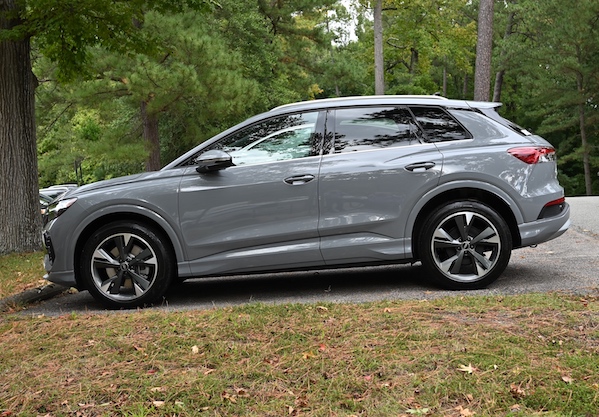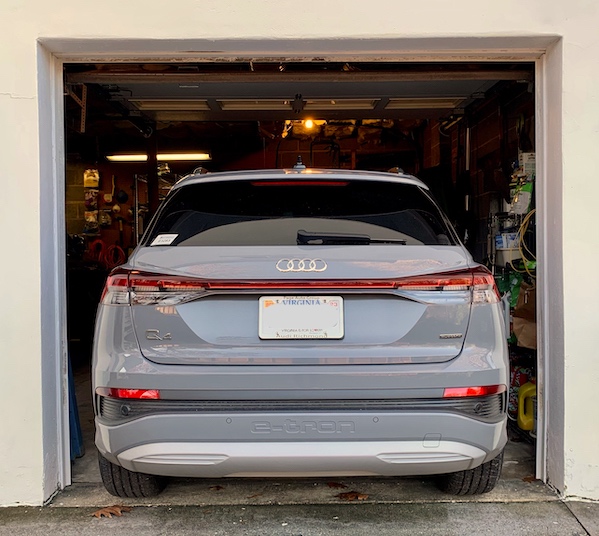

The first twelve months. An EV is just like a car, only better.
Enough about the statistics, how is the car? It's been the most excellent and boring car I have owned. You just get in it and drive, which is exactly what I want. Because it looks exactly like the Q5s in my neighborhood (to most people), it blends in with the usual suspects. Here are some of the best features.
The specific car we bought is a 2022 Audi Q4 50 e-tron. Q4 is Audi’s electric SUV, and 50 refers to the dual motor version. Ours is essentially the base model of the higher end car, and the only extra features it has are 20-inch wheels and a small bundle of convenience features that are convenient but I would not have missed them.

I had ordered one, and Audi Richmond took delivery of a few ahead of the orders. One car that was delivered in the unexpected batch was very close to what I had ordered, and I said, "I'll take it."
The Audi Richmond folks did not charge over sticker. The car was 53.3 base + 3.1 for some extras (color matched 20-inch wheels and the convenience package), $1200 to get it here from Germany, and tax.
I would have preferred the standard wheels. It would be a more comfortable ride for the 26 screws in my spine to have the 19-inch wheels with more air and more tire. Nonetheless, the car is very comfortable. I looked up what the convenience package is, and most of it is blah blah blah. The material elements are:
The blah blah blah features are:
First, there are a number of things that just don’t exist in an EV, and nor does the corresponding dashboard clutter. I do not suffer from nostalgia, but there is a feeling that something is missing in the general cleanliness of the layout. As I now know from several hours at RTFM University, the only user maintenance activity is adding washer fluid when it is low. Yes, that’s all. In fact, the washer fluid tank is the only thing under the hood that you can access. There is
In that sense, there is little to do but drive, something made easier by the fact that the car starts when you get in, turns itself off when you get out, and locks itself if you forget to get in the car. I doubt that the car is ever "off" because in the mornings, (almost) *everything* in the car is exactly as I left it.
There are two schools of thought about the design of the interiors of electric cars. One is the Tesla / Rivian / Polestar school where the interiors reinforce the idea that you are driving an electric car — NCC 1701, specifically. The other school is the Nissan / Audi / Chevrolet approach that intends to make you forget that anything has changed. The first group is all touch screen, and the latter has familiar switches and knobs. For all the joys of the iPad, I find driving less distracting when I push a button that moves and that has an audible click to let me know I did it successfully.
Although there is nothing to do but drive, driving is remarkably different. The Q4 has one forward gear that can be engaged with or without the regen braking at 15% the force of gravity. When the car comes to an almost complete stop, there is a "brake" that engages to hold the car in position, and a little green (A) pops up on the dash. (A) must make sense to someone.
You cannot move the car without depressing the accelerator pedal even if you are pointed downhill. It is difficult to overcome the feeling that you are in a driving simulation, and as we learned in The Matrix and The Thirteenth Floor, reality may be a simulation, and in the case of The Thirteenth Floor, a simulation within a simulation.
Here is a printable, handy efficiency chart that compares the three common measures of energy efficiency used in USA, miles/kWh, MPGe, and kWh/100 miles.
I have been keeping track of my energy use since buying the car — I’m a data science guy, right? I drove my first 757 miles on 263kWh, which is 2.878 miles/kWh, or 114.94 MPGe using the standard conversion for gallons of 87 octane gasoline at STP.
For a 4,861 pound car (not including the driver), that’s good.
It is not the whole story, though. The kilowatt hour spec quoted above is the the energy from discharging the battery, but you are paying for kilowatt hours going into the charger. From the first 1200 miles, I have determined that the efficiency of the charging process is about 88%, or if you prefer to view it from the reverse direction, you need to "buy" 1.13 kWh to get 1.0 kWh into the battery. Some of the loss is heat loss in the charger, and some of it is lost as heat in the battery.
 This is a picture of my home charger, installed by
Electrickman, Inc.,
in Richmond, Virginia.**
This is a picture of my home charger, installed by
Electrickman, Inc.,
in Richmond, Virginia.**
Here are some important points about the installation from top to bottom.
1. Note that the plug is mounted on a board rather than being directly attached
to the concrete, exterior wall of the garage. This prevents corrosion in
the plug.
2. The charger itself is supported by the orange hook just visible
underneath its lower edge. This prevents strain on the electrical
connection between the charger and the plug. The charger is sealed
and not a target for corrosion.
3. Below the charger, the charging cable first goes through a
restaint that prevents it becoming entangled in the tracks for
the garage doors on either side.
4. Finally, the whole cord is wound around hooks so that it does not
present a tripping hazard, nor is there a danger of backing over
the cord with the car.
** One of the principals has a Tesla, so these guys have a lot of
experience with charger installations.
This charger is a fairly standard (but large) size --- 9.6kW. If it can receive 40A of current at exactly 240VAC, it will provide 40*240 = 9600 watts of power to the car. The car can accept AC charging at up to 11.5kW.
The circuit must be a 50A circuit to comply with the electrical code that says a continuous delivery can only be 80% of rating of the circuit --- 0.80 * 50 = 40.
The conduit you see in the photo is around 6AWG wire, which is rated for 60A at ordinary temperatures. So, this circuit is appropriately set for charging an EV.
I think I have already heard enough about "range anxiety." In my internal combustion years, I don’t recall worrying about gas station locations, nor wondering if my car really meant it that there were 50 miles left in the tank. For the past six weeks, I only drove to and from work, my annual physical, and the grocery, and I clocked a meager 675 miles. My car is rated to go 241 miles on a charge.

This is conservative. In the image above, taken during the winter, the display shows 224 miles to go on a 73% charge. After 3 1/2 months of driving (starting on October 3rd), the rate of energy consumption has averaged 29.0kWh/100 miles, or about 82% of what Audi says will be consumed in a mix of highway and city driving.
The routine charging recommendation is to keep the battery between 20% and 80% charged, and only use the completely full to nearly drained range when you are taking a road trip. The battery works best at 75-85F (25-30C), and when you reach the end of your drive, the dash prompts you for your next departure time. It uses your departure time to warm the battery if it needs to. It sounds kind of klutzy, but it is not, and it is only needed in the cooler months.
The big thing about charging versus tanking up is mindset. "Gotta get gas on the way to work (or the way home)," has been replaced by charging the car during the day or overnight. It requires a little bit of thinking ahead, but not so much that I cannot handle it at my advanced age. Charging itself is easy, and although the electricity on campus is free, the process is the same anywhere — I hold my phone up to the charger, the "hose" unlocks from the pump, and I attach it to the car. Locking the car locks the charging cable to the car. When it finishes (or you are ready to leave) your phone receives a text message. You unlock the car and put the hose back. The car cannot be driven while it is attached to the charger, so there is no danger of driving off with the charger clattering behind you.
Public "fast charging" (Level 3) is not nearly so efficient and shortens the life of the battery. OTOH, my car says it will fast-charge from 5% to 80% in 36 minutes. I don’t see how the time spent charging while you get a coffee or lunch on a road trip is a big factor in mobility unless you are in West Virginia, Kentucky, or Mississippi, states that may never have had electricity of any kind.
The Q4 comes with a Level 2 charger for your home use. Level 2 chargers need a 240VAC 30-50A circuit like you may have for an electric clothes dryer. The charger is the expensive item; having the supporting electrical work done is at most a couple of hundred dollars if it is just the circuit, the wire, and the conduit. If it is a long run or you need to bury the line, it is clearly more money. In our case, we had an unused circuit that was once used for an electric cooktop.
Battery capacity is measured in kWh — kilowatt hours, the same unit that is used by the utility company. The battery in the Q4 has 77.5kWh of "usable capacity."
The charger delivers a maximum of 9.6kW: 77.5kWh/9.6kW = 8.07h, so it would take 8.07 hours to go from completely flat to charged if everything was optimal.
However:
A more realistic, real-world measurement is that I can charge from 20% to 80% in a little over 7 hours on our more modest 6kW chargers at work.
This is one of the ways that a battery differs from a tank of gas. A battery is a chemical engine, and its ability to deliver power depends on the availability of the chemicals for the reaction that creates the electrical current. It is something of a simplification, but as the charge level goes down, the chemicals are less available to react.
Something similar happens with temperature. If you think about the limiting case of "absolute zero," there would be no reaction at all at the lowest possible temperature. As the battery gets warmer, things improve. If the battery gets too warm, it once again loses its ability to perform well because the internal resistance gets higher -- just like a hot wire in a toaster.
Perhaps long-time Audi owners will not be surprised. I come from the world of Toyota, and before that BMW and Saab. These things surprised me, and they are worth mentioning.

Perhaps I am too critical because software is my business; not mobile apps, but software is how I have made a living for all of my adult life. There are two reasons to pronounce My Audi (the iPhone version available in late 2022) to be inadequate.
The first is that it does not offer anything that is not already available from the car’s native controls, and as is almost always the case in any device with a "remote control," if the device itself has a built-in way to do the job, it is the preferred, more reliable way.
The second is that the design of the software violates nearly every usability guideline and design guideline that has existed since the invention of the wheel. The next few paragraphs discuss the problems in detail, and perhaps if the right people at Audi get a look at this page, they can change a few things — or more likely, get the consultants to whom they subcontracted the app to change them.
In successful apps all you need your phone and the app’s target, in this case, the car. There should be no need for any additional layer of complexity, authorization, or authentication to make the app work. And it definitely does not need to be a subscriber service considering its incredibly limited functionality.
If I may encourage Audi to focus on the customer and not themselves, let me suggest that they abandon the inward facing design for an outward facing design. Within user interface conversations, an inward facing design means that the product was built to satisfy the people who paid for its development; usually, these people are not the primary users of the product. Outward facing designs reflect a focus on the customers’ experiences.
There are a few featurs that can benefit from having a "remote control," and good designs focus on the intersection of commonly used and beneficial features.